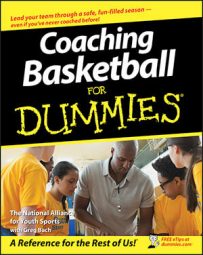Your early practices should offer a peek at a player's ability in specific areas. Scrimmages or games involving just a handful of players and drills are ideal ways to gain a real sense of a child's strengths and weaknesses in certain basketball skills.
After you collect all this information on your players, you can take advantage of it by developing practice plans that focus on improving their weaker areas while enhancing their stronger skills.Footwork
Good footwork pays off on the dance floor and the basketball court. Players who stand or move flat-footed tend to spend more time watching the action, which really affects their productivity (and fun) at both ends of the floor. Players who constantly move their feet create additional scoring opportunities through screens, cuts to the basket, defensive stops, and so on.During practice (and games), keep an eye on a player's feet, because footwork dictates how well they will perform. Watch to see if a player stays on the balls of their feet when dribbling and if they shuffle their feet while defending.
Competitiveness
At the younger levels of play, how competitive a child is shouldn't be a focus. If they stay involved in the game long enough, most kids will gradually become more competitive. In the meantime, stick to helping them have fun, learn the game, and develop skills.At the more advanced levels of play, you should monitor how your players respond to challenges and difficult situations. If certain players are easily rattled, focus on building their confidence and stoking their competitive juices so they'll always put forth their best effort.
To gauge competitiveness during practice, you can challenge the kids. See how many baskets they can make in a row. Or insert yourself into a drill and challenge the players to score on you or box you out for a rebound. Kids love going against their coaches, and if they can perform well against you, it can buoy their confidence.
Body language and demeanor
A basketball player's body language during practice and games speaks volumes. If their head droops or shoulders sag, you can deduce they're probably not thrilled with their or the team's performance. Pay particular attention to the following:- Are they too hard on themselves when shots aren't falling?
- Do they get frustrated when teammates make mistakes?
- Do they embrace your suggestions, or are they easily offended by feedback?
You can improve players' mental approach to the game by imploring them to play each possession as though it's the first of the game. Players who have the ability to push aside prior possessions — whether they involved missed shots or turnovers — and focus entirely on the present put themselves in better position to achieve more success.
Teamwork
Youngsters who fire up and encourage their teammates, during practice and in games, and play an unselfish style of basketball are really valuable. Even when it isn't their turn to be on the floor or participate in a drill, or the scoreboard isn't in your favor, your players can be inspiring by encouraging teammates and applauding their hustle.On the flip side, kids who sulk or don't pay attention to the action on the court or your instructions during practice can damage team chemistry and kill morale.

